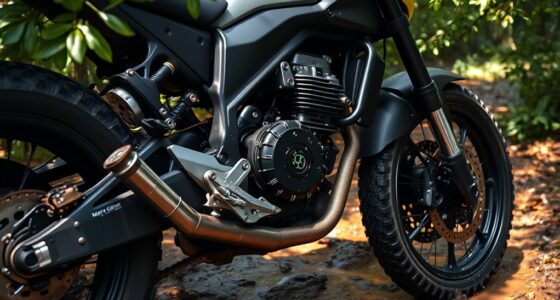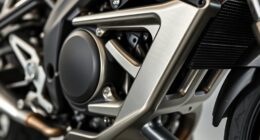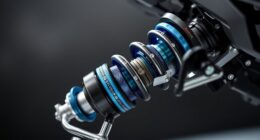Understanding how suspension linkage geometry affects rear-wheel travel helps you improve your vehicle’s performance and comfort. Longer and carefully positioned linkages allow for greater wheel movement, which absorbs bumps better and enhances stability. The angles and lengths of the arms control the arc of wheel travel, balancing between smooth motion and structural strength. By optimizing these aspects, you can fine-tune handling for different terrains. Keep exploring to see how different configurations influence ride quality and responsiveness.
Key Takeaways
- Longer linkage arms typically increase the wheel’s vertical travel range by providing more movement space.
- The placement and angle of pivot points influence the smoothness and extent of rear-wheel movement during suspension travel.
- Linkage length and geometry determine the arc of wheel movement, affecting maximum travel and stability.
- Geometric design controls how the wheel responds to bumps, optimizing ride comfort and preventing excessive movement.
- Adjustments in linkage angles and lengths can improve or limit rear-wheel travel based on terrain and handling needs.
The Basics of Linkage Geometry in Vehicle Suspensions
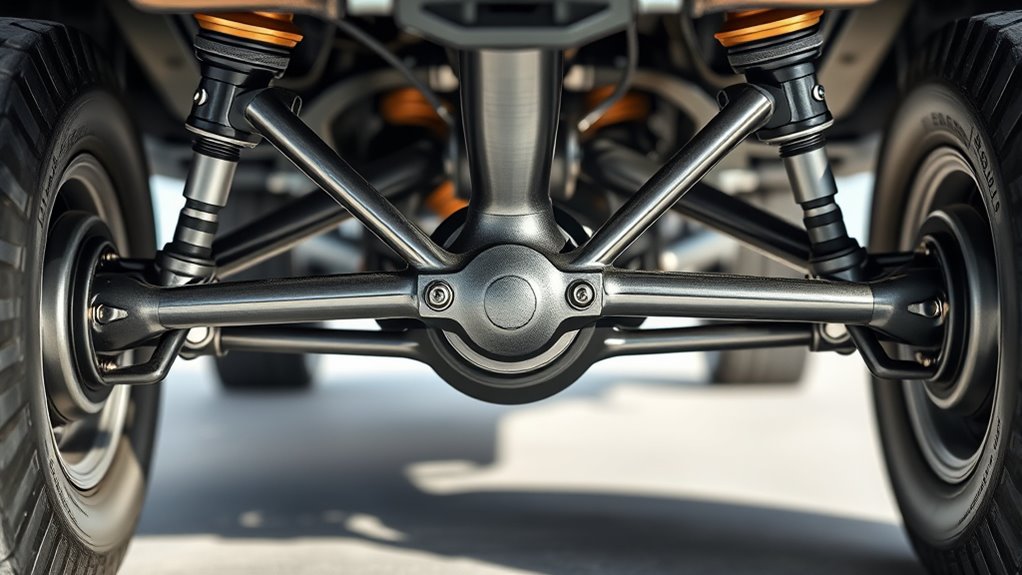
Understanding the basics of linkage geometry is essential for grasping how vehicle suspensions work. When you look at a suspension system, you’re seeing how linkages connect the wheel to the chassis, controlling movement and stability. The geometry determines how the wheel moves in response to bumps and turns, affecting ride quality and handling. Key concepts include the pivot points, lengths, and angles of the linkages, which influence wheel travel and camber changes. As you move over uneven surfaces, the linkage’s design directs the wheel’s path, maintaining contact with the road. Proper suspension alignment is critical for ensuring that the linkage geometry functions optimally, affecting both ride comfort and vehicle safety. Grasping these basics helps you appreciate how different linkage configurations influence suspension behavior, ensuring smoother rides and better control. This foundational understanding sets the stage for exploring specific linkage types and their mechanical principles.
Types of Linkage Systems and Their Mechanical Principles
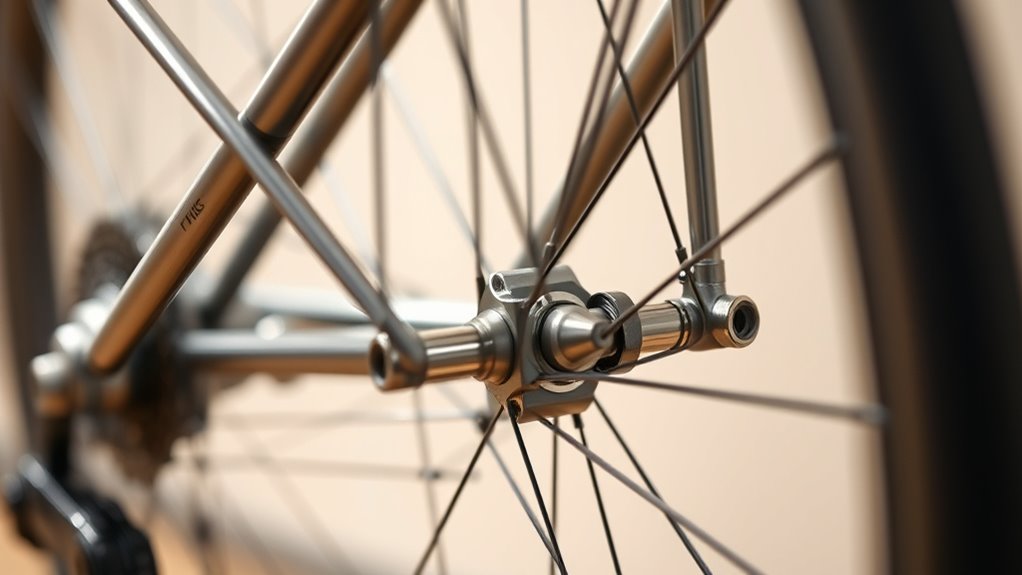
Different types of linkage systems are designed to achieve specific suspension behaviors by varying the arrangement and motion of their components. For example, a four-bar linkage uses four rigid links connected by pivots to control wheel movement, offering predictable and stable travel. A double wishbone setup employs two arms that allow precise control over camber and ride height, enhancing handling. The MacPherson strut combines a coil spring and shock absorber within a single assembly, simplifying design while providing decent performance. Each system operates based on mechanical principles like leverage, pivot points, and geometric constraints, affecting how the wheel moves through its travel. Understanding these types helps you grasp how different linkages influence suspension responses and vehicle handling characteristics. Additionally, AI-powered virtual reality in e-learning can simulate suspension dynamics for educational purposes, providing deeper insights into their mechanical behavior.
How Linkage Design Influences Rear-Wheel Travel Range
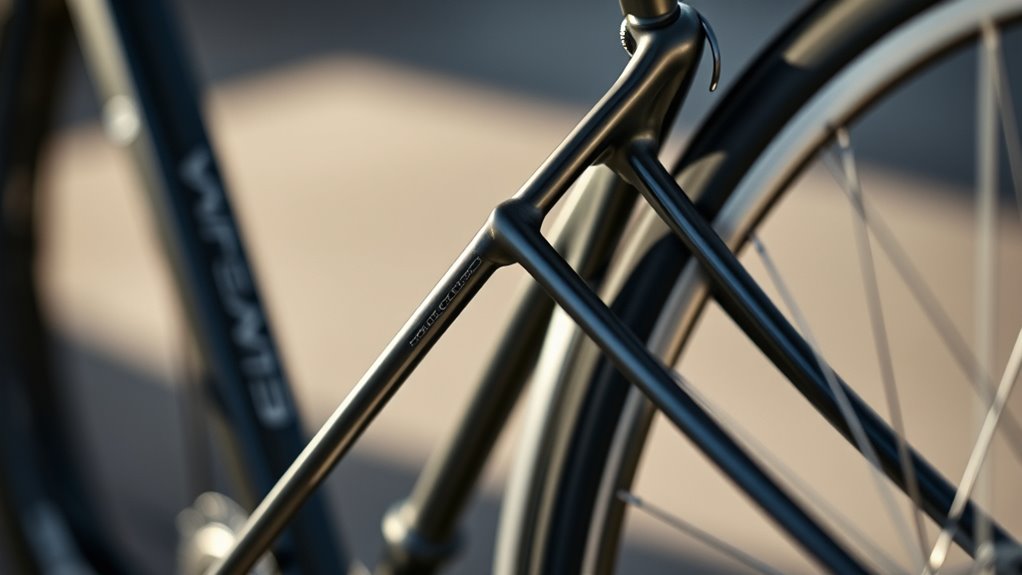
The design of a linkage system directly determines the range of rear-wheel travel by controlling how the wheel moves through its vertical cycle. The length and placement of linkage arms set the limits of movement, affecting how far the wheel can travel upward and downward. Longer linkages typically allow for greater travel, providing more suspension flexibility. The pivot points and their angles influence how smoothly and efficiently the wheel moves, preventing unwanted binding or harsh impacts. By adjusting these components, you control the wheel’s arc, ensuring ideal travel without compromising stability. Ultimately, thoughtful linkage design balances maximum travel with structural integrity, ensuring your vehicle handles rough terrain effectively while maintaining control and comfort.
The Impact of Geometry on Ride Comfort and Handling
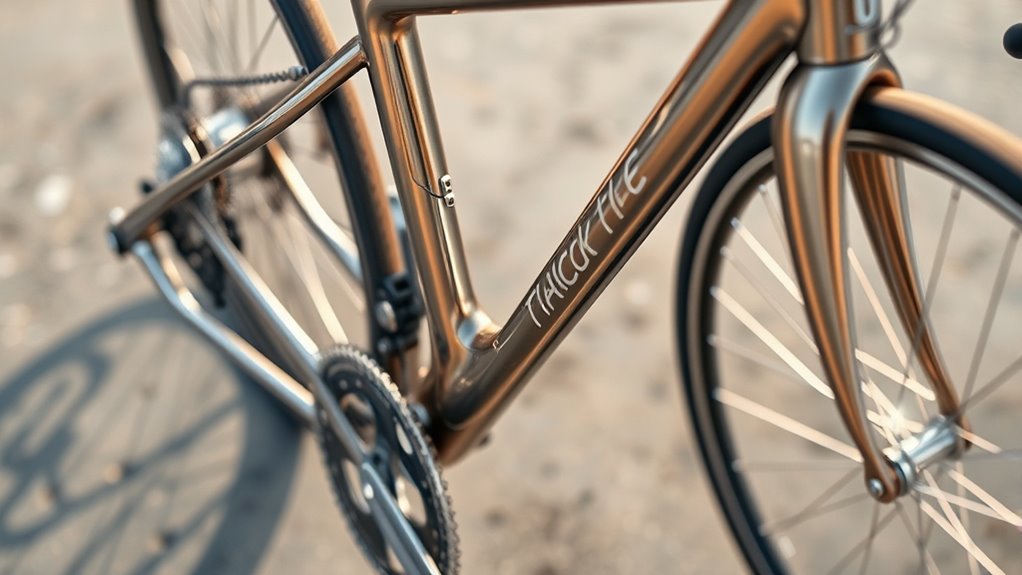
The geometry of your linkage system plays a crucial role in both ride comfort and handling. It influences how smoothly your vehicle absorbs bumps and how precisely it responds to steering inputs. A well-designed geometry minimizes harsh jolts and maintains stability during cornering. Consider the following:
| Aspect | Effect | Your Experience |
|---|---|---|
| Suspension angles | Affect bump absorption and stability | Smoother ride, less body roll |
| Wheel camber | Impacts grip and tire wear | Better handling, longer tire life |
| Linkage length | Controls wheel movement during travel | Consistent ride quality |
| Pivot placement | Determines steering responsiveness | Quick, precise turns |
| Ride height | Influences center of gravity | Improved balance and comfort |
Proper geometry ensures your ride feels controlled yet comfortable, enhancing handling and overall driving experience. Additionally, understanding linkage systems can help optimize performance and durability.
Innovations and Adjustments in Linkage Configurations
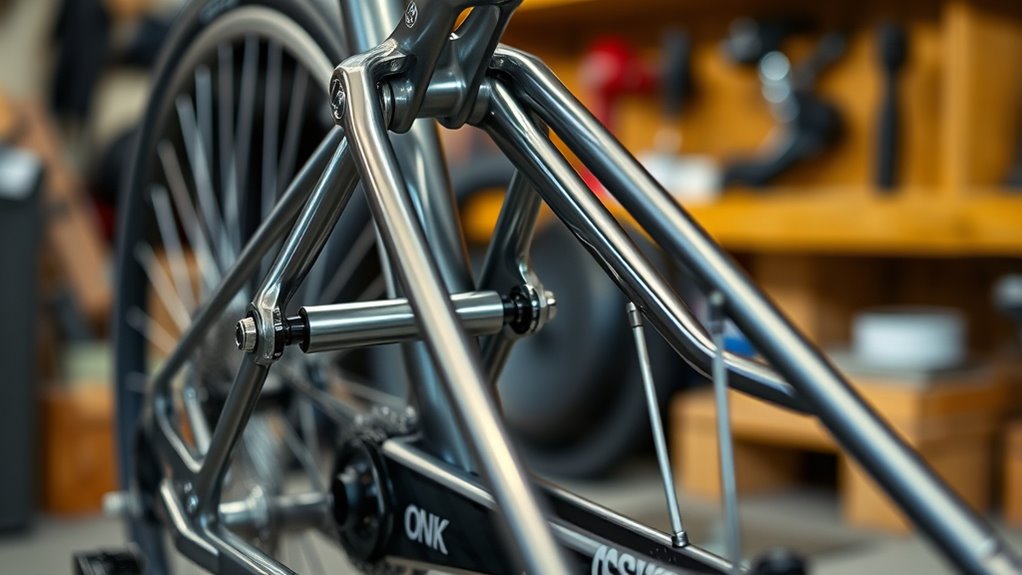
Innovations in linkage configurations continually enhance vehicle performance by allowing precise adjustments to suspension geometry. Modern designs incorporate adjustable linkages, enabling you to fine-tune ride characteristics for different terrains or driving styles. For example, some linkages feature pivot points that can be altered to modify wheel travel or camber angles, improving handling and stability. Active suspension systems now use electronically controlled linkages that adapt in real-time, providing ideal performance and comfort. Additionally, lightweight materials like composites and titanium reduce weight without sacrificing strength, boosting efficiency and responsiveness. These innovations empower you to customize your vehicle’s suspension setup, balancing comfort, traction, and agility. Furthermore, advancements in Honda Tuning have led to the development of performance kits and ECU remapping options that optimize suspension performance and vehicle dynamics. As technology advances, expect even more sophisticated linkage adjustments that seamlessly adapt to driving conditions, elevating overall vehicle dynamics.
Frequently Asked Questions
How Does Linkage Geometry Affect Vehicle Weight Distribution?
You might wonder how linkage geometry influences vehicle weight distribution. When you adjust the linkage angles and pivot points, you change how weight shifts during acceleration, deceleration, and cornering. Proper geometry helps distribute weight more evenly across the wheels, improving traction and handling. By optimizing these linkages, you guarantee your vehicle maintains better balance, reducing tire wear and enhancing overall stability, especially during dynamic driving conditions.
Can Linkage Systems Be Customized for Different Vehicle Types?
Think of linkage systems like a tailored suit—they can be customized to fit different vehicle types perfectly. You can adjust angles, lengths, and pivot points to optimize performance for everything from sports cars to off-road trucks. By customizing these linkages, you guarantee the vehicle’s suspension works efficiently, providing better handling, comfort, and durability. So, yes, linkage systems are versatile and can be tailored to meet specific vehicle needs.
What Materials Are Best Suited for Linkage System Durability?
When choosing materials for a linkage system, you want durability and strength. Steel is a top choice because it’s tough and resistant to wear, making it ideal for heavy-duty use. Aluminum offers a good balance of strength and lightweight properties, improving performance and efficiency. Composite materials like carbon fiber are also excellent, providing high strength-to-weight ratios, but they can be more expensive. Consider your vehicle’s needs to select the best material.
How Does Linkage Design Influence Maintenance Requirements?
Ever wondered how your linkage design impacts maintenance? It determines how often you’ll need to check for wear or lubrication. A well-designed linkage system minimizes movement friction and reduces component stress, meaning less frequent repairs. By choosing simpler, sturdy geometries and quality materials, you lower the chances of breakdowns. So, you should focus on optimizing your linkage design to make maintenance easier and extend the system’s lifespan.
Are There Environmental Factors That Impact Linkage System Performance?
Environmental factors can considerably impact linkage system performance. You’ll want to watch out for dirt, mud, and debris, which can cause wear and clog moving parts. Moisture and rust are also risks, leading to corrosion and reduced efficiency. Temperature extremes can affect lubrication and material expansion, potentially causing stiffness or looseness. Regular cleaning, lubrication, and inspections help you maintain peak performance and extend the lifespan of your linkage system.
Conclusion
Once you grasp how linkage geometry controls rear-wheel travel, you’ll see it’s like wielding a secret superpower over your vehicle’s performance! Your suspension’s design can turn your ride into a smooth, unstoppable force or a wild roller coaster. Mastering these principles releases a world where comfort and handling bend to your will—think of it as the ultimate game-changer that transforms your driving experience into pure, unadulterated mastery!




